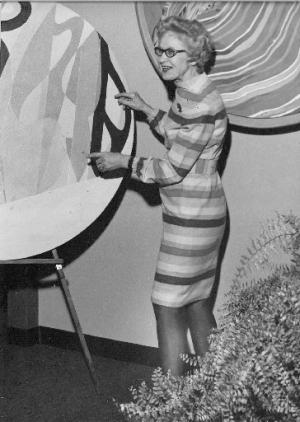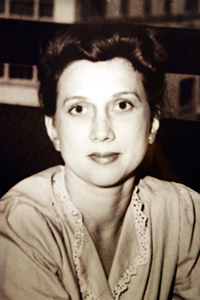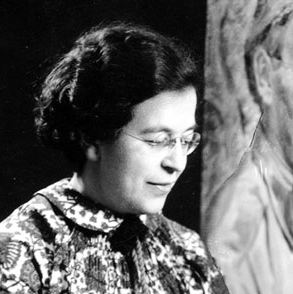Related Research Articles
Allan Capron Houser or Haozous was a Chiricahua Apache sculptor, painter and book illustrator born in Oklahoma. He was one of the most renowned Native American painters and Modernist sculptors of the 20th century.

Olive Rush was a painter, illustrator, muralist, and an important pioneer in Native American art education. Her paintings are held in a number of private collections and museums, including: the Brooklyn Museum of New York City, the Haan Mansion Museum of Indiana Art, the Indianapolis Museum of Art, Indiana and the Smithsonian American Art Museum.

Alice Schille (1869–1955) was an American watercolorist and painter from Columbus, Ohio. She was renowned for her Impressionist and Post Impressionist paintings, which usually depicted scenes featuring markets, women, children, and landscapes. Her ability to capture the character of her subjects and landscapes often resulted in her winning the top prize in art competitions. She was also known for her versatility in painting styles; her influences included the “Dutch Old Masters, James McNeill Whistler, the Fauves, and Mexican muralists.” Her estate is represented by Keny Galleries in Columbus, OH.

Eve Drewelowe (1899–1988) was an American painter, especially renowned in her native Iowa and Colorado, but also widely exhibited nationally.

Margarete Bagshaw was an American artist known for her paintings and pottery. She was descended from the Tewa people of K'apovi or the Kha'p'oo Owinge, Santa Clara Pueblo, New Mexico.
Dorothy Newkirk Stewart was an American printer, printmaker and artist.
Betty Sabo was an American landscape painter and sculptor. She is best known for her realistic oils of New Mexico landscapes.

Marion Boyd Allen was an American painter, known for her portraits and landscapes.

Margaret Lefranc was an American painter, illustrator and editor, an American Modernist with early training as a color expressionist. Lefranc produced portraits, figures, florals, still lifes and landscapes in a variety of compositions. Her media included oil, watercolor, gouache, pastel, drawing, etching and monotypes. At age eighteen, she received accolades from Alfred Stieglitz and, in November 1928, aged twenty-two, received rave reviews in La Revue Moderne, when her works Dancer and Mme M. en Pyjama were shown in Paris.
Barbara Latham was an American painter, printmaker, and children's book illustrator.

Veronica Helfensteller (1910–1964) was an American painter and printmaker, who was a member of the Fort Worth Circle, a group of artists in Fort Worth, Texas, active in the 1940 and 1950s.
Eugenie Frederica Shonnard (1886–1978) was an American sculptor and painter born in Yonkers, New York.
Alice Geneva "Gene" Kloss was an American artist known today primarily for her many prints of the Western landscape and ceremonies of the Pueblo people she drew entirely from memory.
Louise Crow was an American painter best known for her portraits of Pueblo Indians. She worked in oils and watercolors, and with a wide variety of subjects including landscapes, Northwest scenes of rugged mountains, seascapes, and portraits of such historical figures as Ezra Meeker, a pioneer who traveled the Oregon Trail. Her technique was crisp and clean and feels contemporary despite her working nearly one hundred years ago. Much of her work, which has been a challenge to locate, concentrated on California and Southwest themes. Institutions that own her include the New Mexico Museum of Art, the Museum and History and Industry and the Washington State Governor’s Mansion.

Beatrice Mandelman, known as Bea, was an American abstract artist associated with the group known as the Taos Moderns. She was born in Newark, New Jersey to Anna Lisker Mandelman and Louis Mandelman, Jewish immigrants who imbued their children with their social justice values and love of the arts. After studying art in New York City and being employed by the Works Progress Administration Federal Arts Project (WPA-FAP), Mandelman arrived in Taos, New Mexico, with her artist husband Louis Leon Ribak in 1944 at the age of 32. Mandelman's oeuvre consisted mainly of paintings, prints, and collages. Much of her work was highly abstract, including her representational pieces such as cityscapes, landscapes, and still lifes. Through the 1940s, her paintings feature richly textured surfaces and a subtly modulated, often subdued color palette. New Mexico landscape and culture had a profound influence on Mandelman's style, influencing it towards a brighter palette, more geometric forms, flatter surfaces, and more crisply defined forms. One critic wrote that the "twin poles" of her work were Cubism and Expressionism. Her work is included in many major public collections, including large holdings at the University of New Mexico Art Museum and Harwood Museum of Art.
Gina Knee Brook, née Gina Schnauffer, and better known as Gina Knee, (1898–1982), was a twentieth century American artist. She lived and worked in New Mexico, the American South and Long Island, New York.
Holly Roberts is an American visual artist known best for her combination of photography and paint. “Holly Roberts caused a stir in the fine art photography world of the eighties by fusing painting and photography, painting directly onto photographs”. Roberts lives and works in Corrales, New Mexico. Her work is in the permanent collection of several museums in the United States.

Gwendolyn Dufill Mews was a Canadian-born artist who later settled in the United States.
Helen Henderson Chain was an American artist and mountaineer. The majority of her work focused on landscapes in the American West. She has been called the first resident female artist in Colorado.
References
- 1 2 3 4 Motley, Michael (2001). Virginia True. Santa Fe, New Mexico: Zaplin Lampert Gallery.
- ↑ "Non-Modernists Have Attractive Show at Museum" (Daily newspaper). Santa Fe New Mexican . Santa Fe, New Mexico: M. Dana Johnson. 7 March 1931. p. 2. Archived from the original on 11 March 2017. Retrieved 11 March 2017.
While modernists dominate the March exhibit at the art museum, there are several other exhibitions of unusual charm. Miss Virginia True, art instructor at the University of Colorado has a large showing of etchings and paintings. They are of Colorado and New Mexico subjects, many of which are done in a very pleasing manner.
- ↑ Falk, Peter (1999). Who Was Who in American Art 1564-1975 : 400 Years of Artists in America. Madison, CT: Soundview Press. p. 3340. ISBN 0932087558.
- ↑ Kovinick, Phil; Yoshiki-Kovinick, Marian (1998). An Encyclopedia of Women Artists of the American West. Austin: University of Texas. p. 309. ISBN 0292790635.